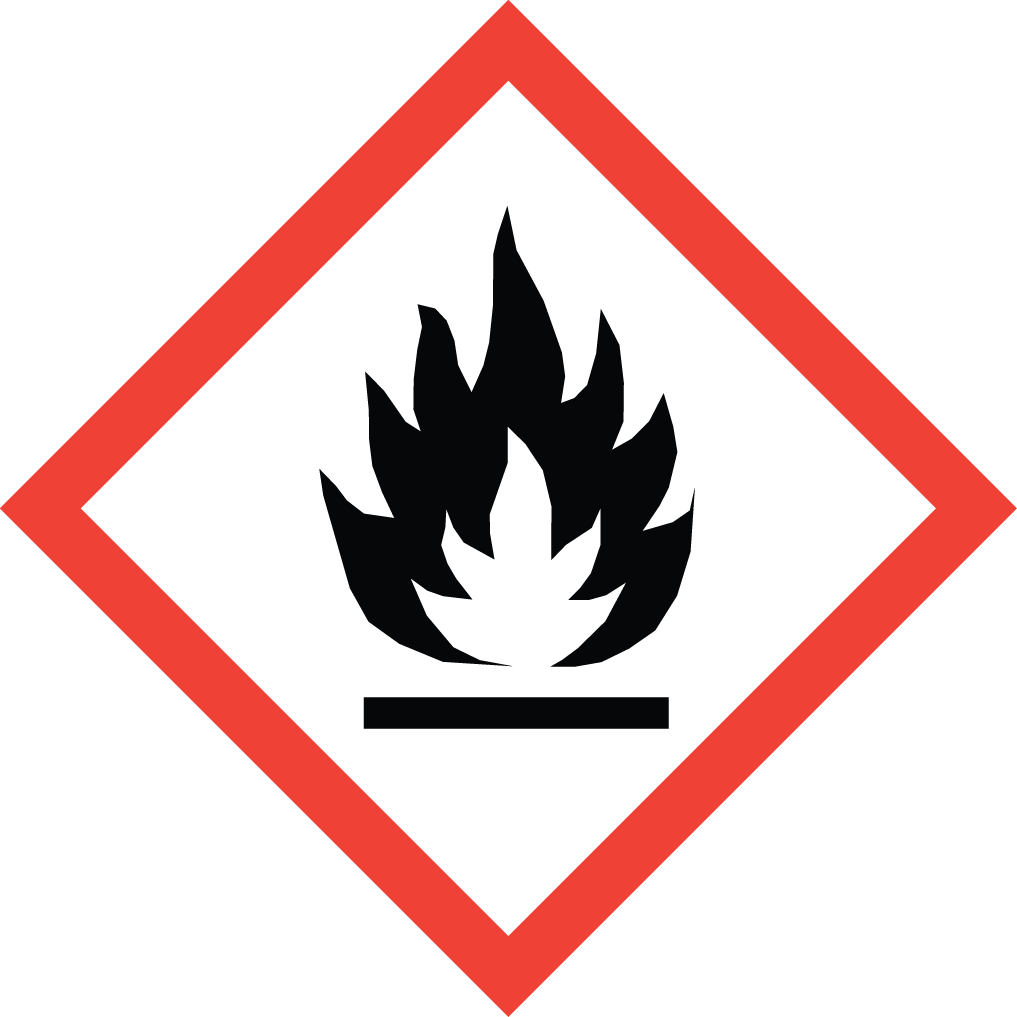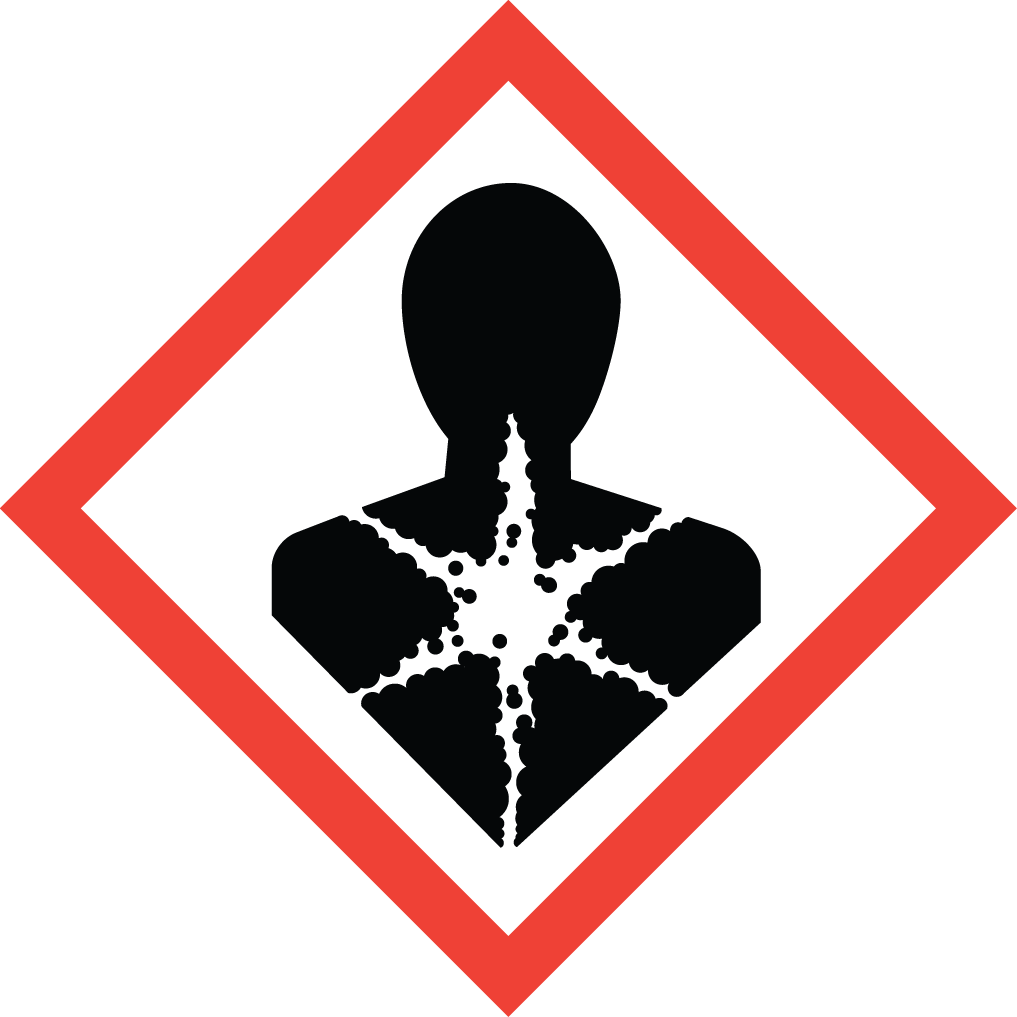Version 3.0
Date revised: 4/26/2019
SAFETY DATA SHEET
Conforms to regulation (EC) no. EU 453/2010
SECTION 1 - IDENTIFICATION OF THE SUBSTANCE/MIXTURE AND OF THE COMPANY/UNDERTAKING
1.1 Product Identifier
1.2 Relevant Identified Uses of the Substance/Mixture and Uses Advised Against
Investigational research by professional users
1.3 Details of the Supplier of the Safety Data Sheet
| Manufacturer National Diagnostics 305 Patton Drive Atlanta, GA 30036 (404) 699-2121 (800) 526-3867 info@nationaldiagnostics.com |
1.4 Emergency Telephone Number
ChemTel Inc.
Contract number MIS8894340
1-800 255-3924 (United States, Canada, Puerto Rico & US Virgin Islands)
01-800-099-0731 (Mexico)
400-120-0751 (China)
000-800-100-4086 (India)
1-300-954-583 (Australia)
0-800-591-6042 (Brazil)
+1-813-255-3924 (All other regions)
SECTION 2 - HAZARDS IDENTIFICATION
2.1 Classification of the Substance or Mixture
Classification according to Regulation (EC) No. 1272/2008 [EU-GHS/CLP]
H225 - Flammable Liquids (Category 2)
H304 - Aspiration Hazard (Category 1)
H340 - Germ Cell Mutagenicity (Category 1B)
H350 - Carcinogenicity (Category 1B)
2.2 Label Elements
| GHS Label Elements | ||
 |  | DANGER H225 - Highly flammable liquid and vapor. |
2.3 Other Hazards
None found.
SECTION 3 - COMPOSITION/INFORMATION ON INGREDIENTS
3.2 Mixture
Chemical Names/Description
Aliphatic hydrocarbons.
Component List
| Component | % Comp. | CAS # | EC # | 1278/2008 Classification |
|---|---|---|---|---|
| Aliphatic Hydrocarbons | 100 | 64741-66-8 | 265-068-8 | H225, H304, H340, H350 |
SECTION 4 - FIRST AID MEASURES
4.1 Description of First Aid Measures
Inhalation
Remove to fresh air. If not breathing, give artificial respiration. If breathing is difficult, give oxygen. Call a physician.
Ingestion
Do not induce vomiting. If swallowed and the person is conscious, immediately give large amounts of water. Get medical attention.
Skin
Immediately flush skin with plenty of soap and water for at least 15 minutes while removing contaminated clothing and shoes. Get medical attention. Wash clothing before reuse. Thoroughly clean shoes before reuse.
Eyes
Immediately flush eyes with plenty of water for at least fifteen minutes, lifting lower and upper eyelids occasionally. Get medical attention immediately.
4.2 Most Important Symptoms and Effects, Both Acute and Delayed
Inhalation
Headaches, dizziness, anesthesia, drowsiness, unconsciousness, and other central nervous system effects, including death.
Ingestion
Minimal toxicity by ingestion.
Skin
Dermatitis may occur with frequent or prolonged contact.
Eyes
Product is only slightly irritating to eye tissue, non injurious.
4.3 Indication of Any Immediate Medical Attention and Special Treatment Needed
Unknown/not applicable
SECTION 5 - FIRE FIGHTING MEASURES
5.1 Extinguishing media
Dry powder, foam, carbon dioxide. (Water may be ineffective.)
5.2 Special Hazards Arising from the Substance/Mixture
Hazardous Combustion Products
Thermal decomposition products may include carbon monoxide, carbon dioxide, and hydrocarbons.
Hazardous Decomposition Products
None
Hazardous Polymerization
Will not occur under normal conditions of use (See Sections 10.4 & 10.5).
5.3 Advice for Firefighters
In the event of a fire, wear full protective clothing and NIOSH-approved self-contained breathing apparatus with full facepiece operated in the pressure demand or other positive pressure mode.
5.4 Further Information
No data available.
SECTION 6 - ACCIDENTAL RELEASE MEASURES
6.1 Personal Precautions
Wear appropriate protective equipment as specified in Section 8.
6.2 Environmental Precautions
Prevent discharge into the environment. Dike spills and stop leakage where practical. Do not allow material to enter drains.
6.3 Methods and Materials for Containment and Cleaning Up
Eliminate source of ignition. Ventilate area. Cover with absorbent material (soda ash) to confine spill and sweep or shovel into container. Close container tightly. Avoid breathing vapors.
6.4 References to Other Sections
For disposal information see Section 13. For protective clothing and equipment see Section 8.
SECTION 7 - HANDLING AND STORAGE
7.1 Precautions for Safe Handling
Avoid contact and inhalation. Do not get in eyes, on skin, on clothing. Wash thoroughly after handling. Transfer methods should avoid static sparks. Use explosion proof ventilation.
7.2 Conditions for Safe Storage (including any incompatibles)
Keep in a tightly closed container, stored in a cooled, dry, ventilated area away from sources of heat or ignition. Protect from physical damage. Isolate from incompatible materials (section 10).
Incompatibles
Strong oxidizing agents.
7.3 Specific End Uses
Investigational research by professional users
SECTION 8 - EXPOSURE CONTROLS/PERSONAL PRECAUTIONS
8.1 Control Parameters
ACGIH Threshold Limit Value (TLV):
400 ppm
OSHA Permissible Exposure Limit (PEL):
None established
8.2 Exposure Controls
Engineering Controls
A system of local and/or general exhaust is recommended to keep employee exposures below the Airborne Exposure Limits. Local exhaust ventilation is generally preferred because it can control the emissions of the contaminant at its source.
Respiratory Protection
If the exposure limit is exceeded, wear a supplied air, full-facepiece respirator, airlined hood, or full-facepiece self-contained breathing apparatus.
Eye Protection
Safety glasses.
Skin Protection
Wear protective gloves and clean body covering clothing.
SECTION 9 - PHYSICAL AND CHEMICAL PROPERTIES
9.1 Information on Basic Physical & Chemical Properties
| a. Appearance | Clear colorless liquid | b. Odor | None |
| c. Odor Threshold | N.A. | d. pH | N.A. |
| e. Melting/Freezing Point (oC) | Less than -76 | f. Boiling point (oC) | 118-140 |
| g. Flash Point (oC) | 7 | h. Evaporation Rate | 1.6 (n-Bu Acetate=1) |
| i. Flammability | Combustible | j. Upper/Lower Flammability or Explosive Limits | LEL: 1.3%; UEL: 10.2% @ 25oC |
| k. Vapor Pressure | 36mmHg @ 20oC | l. Vapor Density (Air = 1) | 3.9 |
| m. Relative Density | 0.72 @ 15.5oC | n. Water Solubility | Less than 0.01 @ 25oC |
| o. Partition Coefficient n-octanol/water | Mixture | p. Autoignition Temperature (oC) | 382 |
| q. Decomposition Temperature (oC) | Not applicable. | r. Viscosity | No data available. |
| s. Explosive Properties | Combustible liquid and vapor | t. Oxidizing Properties | Not an oxidizer |
SECTION 10 - STABILITY AND REACTIVITY
10.1 Reactivity
Reactive with strong oxidizer. Combustible liquid and vapor.
10.2 Chemical Stability
Stable under normal conditions of use.
10.3 Possibility of Hazardous Reactions
Will not occur under normal conditions of use (See Sections 10.4 & 10.5).
10.4 Conditions to Avoid
Heat, sources of ignition.
10.5 Incompatible Materials
Strong oxidizing agents.
10.6 Hazardous Decomposition Products
None
SECTION 11 - TOXICOLOGICAL INFORMATION
Product LD50 Values
Oral Rat LD50 (mg/kg)
Minimal toxicity by ingestion.
Dermal Rabbit LD50 (mg/kg)
Minimal toxicity by skin contact.
Component Cancer List Status
| NTP Carcinogen | |||
| Known | Anticipated | IARC Category | |
|---|---|---|---|
| Aliphatic Hydrocarbons | No | No | None |
Potential Health Effects
Inhalation
High vapor/aerosol concentrations (greater than approximately 1000 ppm) are irritating to the eyes and the respiratory tract, may cause headaches, dizziness, anesthesia, drowsiness, unconsciousness, and other central nervous system effects, including death.
Ingestion
Minimal toxicity by ingestion, though small amounts of this product aspirated into the respiratory system during ingestion or vomiting may cause mild to severe pulmonary injury, possibly progressing to death.
Skin
Low order or toxicity. Frequent or prolonged contact may irritate and cause dermatitis. Skin contact may aggravate an existing dermatitis condition.
Eyes
Slightly irritating but does not injure eye tissue.
Carcinogenicity
Not listed by NTP, IARC, or OSHA.
Mutagenicity
No information available.
Reproductive Toxicity
No information available.
Teratogenic Effects
No information available.
Routes of Entry
Inhalation or by skin contact.
Target Organ Statement
No information available.
SECTION 12 - ECOLOGICAL INFOMATION
12.1 Toxicity
| Vertebrates | Invertebrates | Algae | Microorganisms | |
|---|---|---|---|---|
Aquatic Toxicity (ppm unless otherwise noted) | LC50 (96hr, rainbow trout) 18mg/L | EC50 (48hrs, daphnia) 0.4mg/L | EbL50 (48 hr) 10-30mg/L | No data |
| Birds | Arthropods | Plants | Microorganisms | |
|---|---|---|---|---|
Terrestrial Environment Toxicity (ppm unless otherwise noted) | No data | No data | No data | No data |
12.2 Persistence and Degradability
Inherently biodegradable
12.3 Bioaccumulative Potential
No data
12.4 Mobility in Soil
No data
12.5 Results of PBT and vPvB Assessment
No data
12.6 Other Adverse Effects
None
SECTION 13 - DISPOSAL CONSIDERATIONS
13.1 Waste Treatment Methods
Offer surplus or non-recyclable product to licensed disposal company. Disposal is subject to user compliance with applicable law and product characteristics at time of disposal. Dispose of packaging as product.
SECTION 14 - TRANSPORT INFORMATION
| ADR/RID | IATA | IMO | DOT | |
|---|---|---|---|---|
| 14.1 UN Number | 1268 | 1268 | 1268 | 1268 |
| 14.2 Shipping Name | Petroleum Products N.O.S. | Petroleum Products N.O.S. | Petroleum Products N.O.S. | Petroleum Products N.O.S. |
| 14.3 Hazard Class | 3 | 3 | 3 | 3 |
| 14.4 Packing Group | II | II | II | II |
| 14.5 Environmental Hazards | N.A. | N.A. | Not regulated | N.A. |
| 14.6 Special Precautions | N.A. | N.A. | N.A. | N.A. |
SECTION 15 - REGULATORY INFORMATION
15.1 Safety, Health and Environmental Regulations/Legislation Specific for the Substance/Mixture
United States
TSCA Regulatory Statement
All intentional ingredients are listed on the TSCA Inventory.
SARA 311/312 Hazard Categories
| Component | Fire | Pressure | Reactivity | Acute | Chronic |
|---|---|---|---|---|---|
| Aliphatic Hydrocarbons | Yes | No | No | Yes | Yes |
Europe
EEC Regulatory
All intentional ingredients are listed on the European EINECS Inventory.
SECTION 16 - OTHER INFORMATION
Revisional Updates
4/26/2019 - Updated Section 1.4
5/29/2015 - Updated Sections 2.1 and 3.2
11/7/2013 - Released Version 1.0
NFPA Codes
Health 2 Flammability 3 Reactivity 0
Dangers
Aliphatic Hydrocarbons
H225 - Highly flammable liquid and vapor.
H304 - May be fatal if swallowed and enters airways.
H340 - May cause genetic defects.
H350 - May cause cancer.
MANUFACTURER DISCLAIMER: The information given herein is offered in good faith as accurate, but without guarantee. Conditions of the use and suitability of the product for particular uses are beyond our control. All risks of use of the product are therefore assumed by the user. Nothing is intended as a recommendation for uses which infringe valid patents or as extending license under valid patents. Appropriate warnings and safe handling procedures should be provided to handlers and users.